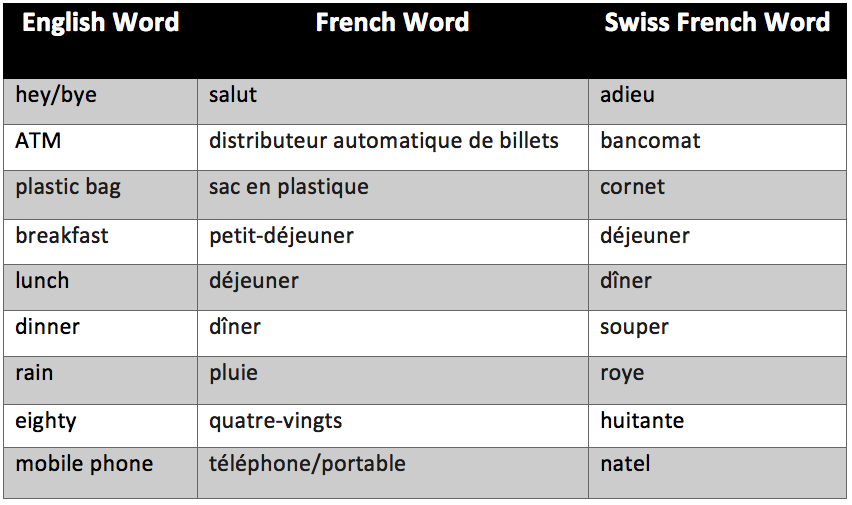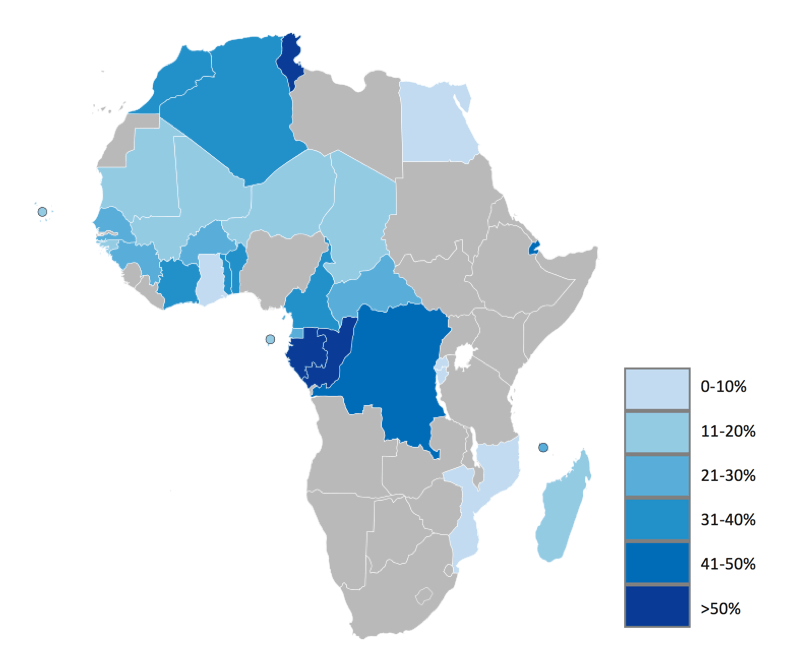Since their vast colonial empire, the realms of French have extended far beyond borders. However, the further the language has travelled, the more it has evolved, influenced by the culture of its location and their communities.
SWISS FRENCH
Considering the fact that it shares borders with France, it is no wonder that Swiss French is nearly identical to mainland French. As one of Switzerland’s official languages (alongside German, Italian and Romansh), approximately 29% of the population are Francophones. Despite this, there are a few lexical differences that could cause confusion if you are unaware of them. The table below highlights some of the more useful words or phrases you would need to remember if speaking French in Switzerland.

Another significant variation in Swiss French is the intonation. In France, the last syllable of a French word is emphasized whereas in Switzerland, the locals instead stress the penultimate syllable. Although it varies from region to region, the overall sound of Swiss French is distinctly different to what you would hear in France.
BELGIAN FRENCH
Belgium is another nation where the French language is dominant; an immense 45% of their population are Francophones. Due to the nation’s proximity to Switzerland as well as France, Belgian French is very similar to both variations of the language. For example, the number 70 is septante instead of soixante-dix and 90 is nonante instead of quatre-vingt-dix. This is identical to Swiss French (see above). Belgian French does have its own differences however. Lexis specific to Belgium are known as “Belgicisms” and include:
- un chope – a drink (in French it is une boisson)
- s’il vous plait – here you go (in French it is voilà)
- sur – sour (in French it is acide)
- blinquer – to shine (in French it is briller)
Pronunciation also varies between mainland French and Belgian French. For example, a Belgian French accent is said to be “stronger” than a Frenchman’s accent due to a clear distinction between long and short vowels. This is considered a result of the presence of Dutch in the country, another official language in Belgium. Additionally, the letter ‘w’ is pronounced clearly in Belgian French whereas mainland French often substitutes it with a ‘v’ sound.
CANADIAN FRENCH
Canada is home to millions of Francophones, compromising 22% of its population. In Quebec alone, 95% of the population are native Francophones. As a result, Canadian French is extensively present and even has equal status to English at a federal level. Although not drastically different in writing, Canadian French can seem considerably distinct when spoken. This is because the Canadian French accent is similar to an older form of mainland French which can seem quite foreign to the modern French speaker.
Like all other variations of French, there are a few words or phrases that are individual to Canadian French. For example, un breuvage is a drink whereas in France this is known as une boisson. Similarly, a stove in Canada is une fournaise but in France is known as une chaudière. Canadian French vocabulary can also vary due to their meaning; in Canadian French, a blueberry is a bleuet whereas in France bleuet means a cornflower. Similarly, a crèche is an orphanage but in France refers to a daycare centre.
Canadian French has also been significantly influenced by English. Words such as blonde (girlfriend), chum (boyfriend) and c’est le fun (it’s fun) are all influenced by English. This type of Canadian French is known as Chiac and derived from colonial times when English speaking communities resided nearby.
AFRICAN FRENCH
French is spoken by approximately 120 million people across Africa in 24 Francophone nations. This determines Africa as the continent with the largest number of French speakers. Although it is a more recent colonial language in comparison to the indigenous languages of the continent, it is considerably dominant. The map alongside depicts the number of French speakers in African countries in 2014.
Percentage of French speakers in Africa in 2014
There are many versions of French spoken in Africa. The most recent variant of African French is called Français Populaire Africain, ‘Popular African French’ or FPA. It is most commonly spoken in sub-Saharan Africa. Often, FPA makes little sense to European French speakers as many phrases are based on African Creole languages and their vocabulary. An example of this is the word mogo, which often used to refer to either a friend or someone of the upper class. Understanding is further complicated by the fact that these Creole languages vary considerably from country to country, meaning that even within Africa there is difficulty understanding all Francophones.
African French also differs to European French because it is based upon more traditional forms of French used in previous centuries. These are far less common in Europe today however still prevalent in Africa.
These variations in the language are vital to know and implement when translating into French, enhancing the accuracy of your work. Creative Word provide a range of services including interpreting, transcription and translation that take into account these differences. Please contact us for more information or help with understanding the language of French.


Recent Comments